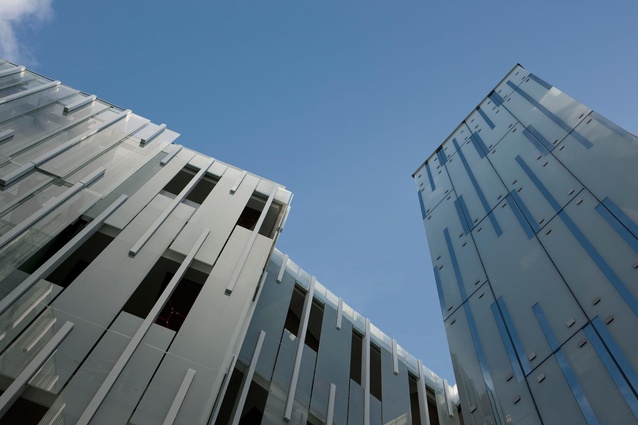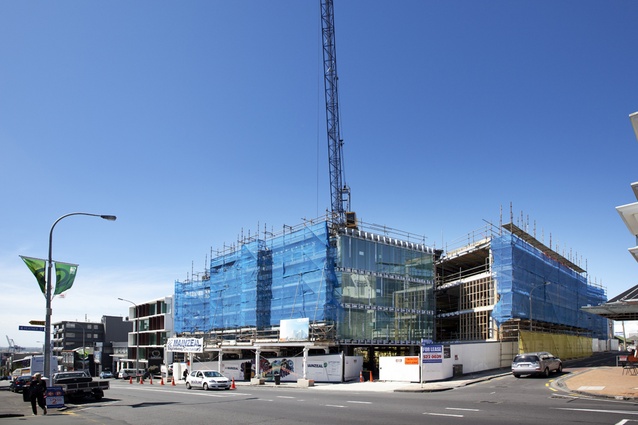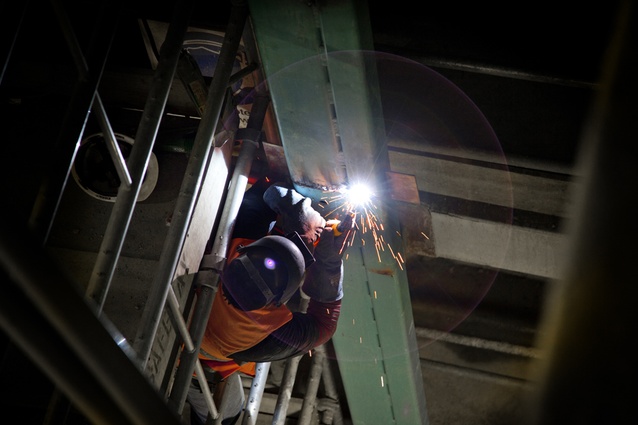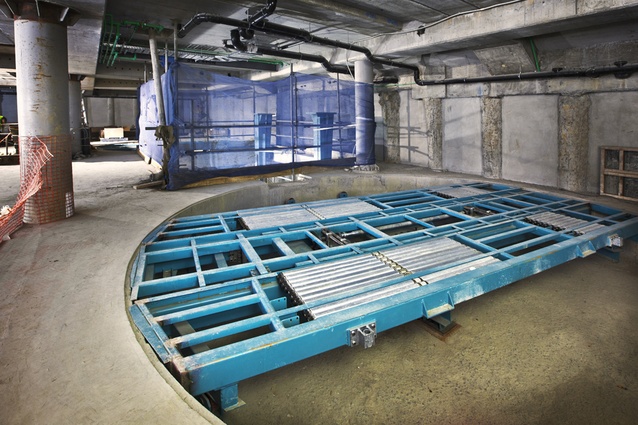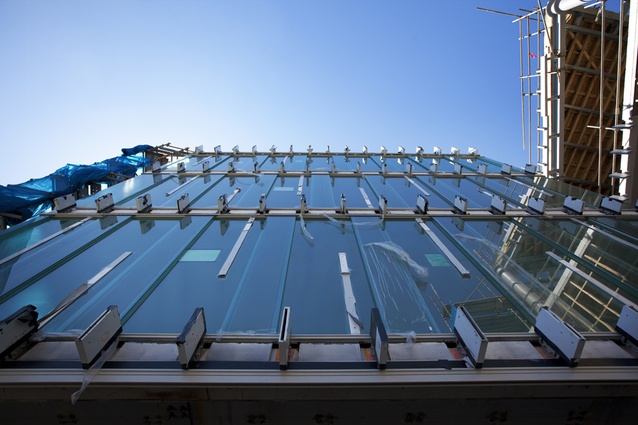Geyser building
New Zealand’s first 6 Green Star – Office Design building takes shape in Auckland’s Parnell.
If you happen to look at Auckland’s skyline eastwards towards Parnell, you will see a large tower crane looking lonely and incongruous halfway up Parnell Road.
The crane looks out of place in this bustling, trendy part of town. It sits on the site of the new Geyser development, currently a large, busy, compact Mainzeal construction project which, at first glance, gives little indication that anything special is happening there.
Closer inspection, however, reveals something quite interesting indeed – the construction of New Zealand’s first 6 Green Star – Office Design rated building.
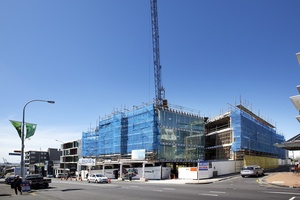
The office/retail complex, commissioned by Samson Corporation, is designed to use 27 per cent of the energy of a typical building its size. Samson engaged architects Patterson Associates for the project. According to Pattersons, essentially what is being built today is unaltered from the 2001 concept. General manager for Samson Corporation, Marco Creemers says Green Star ratings are a natural progression for their business and meeting the challenge took significant effort from all parties involved. “We think green building practices are the future. Achieving the first 6 Green Star certification for Geyser is a result of doing things differently, with more thought to choices during the design process.”
The complex is made up of five individual buildings set around a series of atriums linked by external walkways, stairways and lifts, which feed into a central courtyard space. The site has three street frontages and occupies the entire end of a city block. Each building is wrapped in a unique twin-skin façade, interspersed with GRC glass (fibreglass) reinforced concrete panels, which is designed to allow natural heating and cooling, eliminating the need for mechanical air conditioning or heating.
The façade creates thermal currents, which rise up through the void spaces between the two skins. The outer laminate of the façade is Pilkington’s Eclipse Advantage ‘Low E’ manufactured in the US. The façade naturally heats each building by trapping warm air between the two walls in the winter, significantly minimising heat losses overnight and ‘pre-warming’ outside air during the day. In the hottest months the entire outer skin opens electronically to fully ventilate the cavity by creating cross convection currents from the cooler southern elevations of the buildings, and occupants can open a series of sliding panels to regulate ventilation.
There are individual weather stations on each of the five buildings, which are connected to the building’s management system, and they monitor wind speed and rain, along with internal sensors for temperature and carbon dioxide, to control the twin skin façade. Andrew Mitchell, director at Pattersons, says that the twin façade was designed by the consultant team with peer reviewing by Aurecon. When Mainzeal won the tender contract, the façade become a design and build element by King Façade New Zealand.
“From day one this building was to be naturally ventilated,” says Mitchell. “The façade had to perform to Auckland’s sub-tropic weather patterns. It has a fully automated outer skin that opens on hot days, closes in high winds, and on rainy and cooler days. The building’s occupants have individual control of the inner façade and can tap into the twin-skin air at any time. A ceramic frit to the low-iron glass was added to the outer skin for increased shading co-efficiency.”
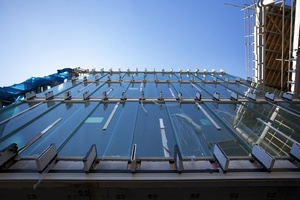
While the façade contributes a significant amount towards the building’s 6 Green Star rating – awarded in 2009 – there are a number of other factors that the New Zealand Green Building Council (NZGBC) have taken into consideration when assessing Geyser for their Green Star rating. The building has a lower energy demand, which covers the ‘energy efficient’ building criteria and is designed to use only half the artificial lighting of a typical retail / office building.
Caine Penny, Mainzeal’s on site project manager, says the project team are actively targeting additional Green Star points for the Built rating than what was originally awarded in the design submission. “For example, there were some areas of minor ground contamination on the site – hydrocarbon and heavy metal contamination – which were unknown during the design submission but discovered during the building and resource consent stage,” says Penny. “Undertaking the remedial action plan requirements to satisfy the council enabled us to target additional Green Star points.”
Liz Root, Mainzeal’s sustainability manager, says reviewing the Green Star points schedule for the Design rating for Geyser provided the starting point for Mainzeal’s involvement with the project’s Green Star journey. “It gives a clear framework for us to understand the project team and our client’s aspirations for the project. We were able to use our experience to advise of any potential challenges implementing the points targeted and provide opportunities to target additional points.”
Andrew Mitchell says solar water heating, grey water recycling and natural ventilation, were just some of the innovations they intended from day one. “When Green Star came along to us in 2006, an assessment told us the building was a 5 star rating,” says Mitchell. “Green Star allowed us to critique the design decisions we had already made, to push them even further and we were awarded a 6 star rating. We think the subtle adjustments made certainly improves the building for the occupants,” says Mitchell.
Tricia Love Consultants were the Green Star accredited professionals engaged by the client for the Design rating and are now working on the Built submission. Mainzeal work closely with them to ensure the project is tracking well, providing them with the required documentation – which then goes to the NZGBC for assessment. The tenancy spaces of each of the buildings are open plan, with floor to ceiling glass and each has a service pod area with a small kitchenette and bathroom. The layout of the tenancy areas is similar on each floor, and each has been designed to be flexible enough to be adapted by individual tenants as required.
There are four levels on the upper floors – ground floor retail and three floors of office space – and five basement levels, with 165 car parks, serviced by an automated car staking system. The B1 basement has two lift lobbies, changing facilities (showers and lockers for tenants), a bicycle storage area, rubbish rooms, controls and electrical switchboard rooms and a rainwater harvest tank for irrigation and non-potable water supply.
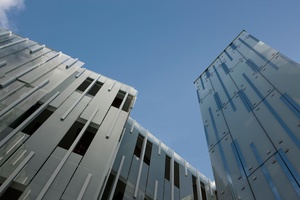
Mainzeal have a specialist in-house project definition team, who produced Building Information Modelling (BIM) of the project in the early stages, by taking material from all the design consultants and creating a 3D model and database. By providing full BIM modelling showing the integration of the building structure with the double-skin façade, Mainzeal were able to sort out issues early within the virtual world, which made for a smooth and efficient construction phase.
Looking into the central cavity as it is being constructed, you can see the difficulty the team had in working in a confined space in an urban environment. “It’s very similar to a CBD project when from the outset you know you haven’t got any spare space,” says Penny. “This is a large site, but it’s fully occupied. There is no spare space available for on-site storage. Because of this, deliveries are ‘just in time’. And then it’s a process of what falls inside or outside of that and how far you can push those boundaries of accepting more material than you actually need at a given time.”
There is a loading bay on Parnell Road, which has been used since the beginning of the project. “During the piling we had a haul road that went through the site but this was still squeezed for space,” says Penny. Largely because of the size and shape of the site, the construction of the building was not your traditional ‘from the ground’\ up’ build; more ‘top down’. Construction has had to be simultaneous for both upper and lower levels.
“The ability to do lower basement excavation works while you’re constructing the structure up above is not a unique construction process but it has its challenges,” says Penny. “We piled around the perimeter of the site and installed the B1-floor level and the ground-floor level. Both of those acted as diaphragms across the site to retain and provide strutting bracing to the surrounding boundary. We then dug out underneath, and as we went down we picked up some floors at each of the ends of the building until we got right down to the bottom of the lower level. We poured the bottom slab and then started building the floors as we came up.”
It meant that one of the five buildings being built had to be left until basement excavation work was finished. Once that stage was reached, the efficient use of the long-reach excavator ended, so the long reach was demobilised but diggers continued working in the basement. Spoil was skipped out with the tower crane and loaded straight into trucks – three skiploads per truck. At the height of the lower- basement excavation work with the long reach, they were averaging 22 truckloads a day of spoil.
The car-stacking machine is a unique feature of the building. On the B1 level are four ‘virtual garages’. On entering the basement you swipe your access-control card, and are then directed to proceed to an assigned virtual garage. “You park your car and swipe your card again to confirm that you have completed the parking process,” says Penny. “Then the turntable in the virtual garage spins the car around to the orientation for loading onto a car lift, which lowers it down to a lower level where a shuttle parks the car in the available space.”
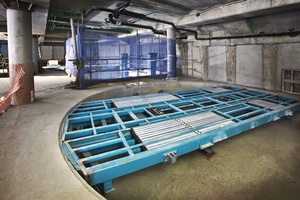
The car-parking machine is very precise and parks cars with only a 75 to 100mm space between wing mirrors. And because it’s linked in to the access-control system for the building, you can use your swipe card in the lift or at the pay stations. If you’re a visitor you go to the pay station, pay your fee for your stay, and when you leave, your car will automatically be retrieved. A display will indicate the approximate waiting time for the car.
The site works five and a half days a week. “There’s resource consent restrictions placed on working hours because the site is in a semi-residential area,” says Penny. “We can’t start before 7.30am and [can only work] up to 6pm on weekdays and between 8am to 1pm on Saturdays.” The site is in an urban area, with a close mix of residential and business neighbours, so keeping friendly relations is vital, says Penny. “In terms of dealing with our neighbours, we try and keep it on a casual and informal basis. If there’s issues or if something’s coming up which we know will create disturbance we will go and see them.”
Being located within the sacrosanct Auckland Museum height plane limit and historic Parnell, required close consultation with the council. “In the end we were able to get our client approximately 800 sq m of net lettable floor area over and above the maximum floor area allowed by council on the site,” says Mitchell. “But at the forefront of the design was the desire to reduce future tenants’ OPEX costs through environmentally sustainable design. The planning concept resolved the site and environmental constraints by taking the building floor area and arranging it into a series of individual sub-buildings, centered around a pedestrian system of courtyards. This allows significant light and air penetration to a great percentage of the lettable space.”
In keeping with the sustainable philosophy of this build, Mainzeal is undertaking an ‘embodied energy’ study on the project. They are recording all the man hours, the labour and the materials’ source-of-origin information to get an overall picture of the carbon footprint of the project. “The understanding of embodied energy and the associated carbon footprint is there within a number of industries, but this information is limited in terms of getting it down to the final construction phase of a building,” says Penny.
Liz Root says the on-site team are collecting data to enable them to develop an embodied energy model for the project. Data is scheduled and then has energy intensity and carbon dioxide emissions factors applied to it to produce an overall embodied energy figure. “This is progressing well and we are already coming across some interesting findings,” says Liz. “While the results will be specific to the construction approach taken for Geyser, it provides the opportunity of making us more aware of our business impacts. Data will be analysed for trends and relevant conclusions drawn that will be useful in understanding the source of energy and associated carbon emissions in future construction projects.”
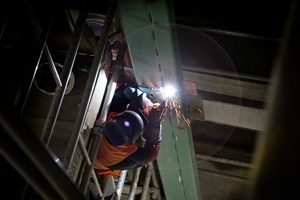
This has included collecting data not only on where building materials are produced and sourced, but also recording information on the workforce on the site, such as where they live and how they get to work each day. “Alongside the clear design documentation provided by the project team, our on-site management procedures are key to the successful delivery of the Green Star Built rating,” says Liz. “Green Star is incorporated into our trade contracts, site inductions and toolbox talks to ensure that everyone on site is up to speed with the project’s Green Star commitments.”
The NZGBC says that while much of the focus tends to be on easily measured benefits such as energy and water savings, just as important is the quality of the working and living environment of green buildings, boosting productivity, reducing absenteeism and acting as a major draw- card for tenants.
Alex Cutler, chief executive of the NZGBC, says the 6 Green Star certified rating for Geyser’s design represents world leadership in green building practices. “It was the first building in New Zealand to achieve a 6 Green Star – Office Design rating,” says Cutler. “Green buildings deliver significant tangible benefits including energy and water savings as well as improved working environments for increased staff productivity and lower absenteeism.”
Andrew Patterson of Pattersons says the project was a collaborative effort. “Dozens of people from a huge range of disciplines were involved, from structural engineers, electrical engineers, hydraulic service designers, mechanical and façade engineers, all working in collaboration,” says Patterson. “We wanted to make Geyser holistic, not just about accommodation and technical performance but also about expressing an Auckland sense of place for people.”
The Geyser building will have 5040 sq m of retail and office space and is due for completion in March 2012. Samson Corporation say tenancy leases are still available for both office and retail.
More information can be found at www.geyserparnell.co.nz.

